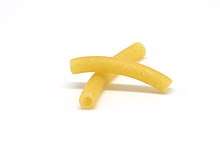Macaroni
 | |
| Alternative names | Maccheroni |
|---|---|
| Type | Pasta |
| Place of origin | Italy[1] |
| Main ingredients | Durum wheat |

Macaroni (/ˌmækəˈroʊni/, Italian: Maccheroni) is dry pasta shaped like narrow tubes.[2] Made with durum wheat, macaroni is commonly cut in short lengths; curved macaroni may be referred to as elbow macaroni. Some home machines can make macaroni shapes, but like most pasta, macaroni is usually made commercially by large-scale extrusion. The curved shape is created by different speeds of extrusion on opposite sides of the pasta tube as it comes out of the machine.
In North America, the word "macaroni" is often used synonymously with elbow-shaped macaroni, as it is the variety most often used in macaroni and cheese recipes.[3] In Italy, the noun maccheroni refers to straight, tubular, square-ended pasta corta ("short-length pasta"). Maccheroni may also refer to long pasta dishes such as maccheroni alla chitarra and frittata di maccheroni, which are prepared with long pasta like spaghetti.
Etymology
The name comes from Italian maccheroni [makkeˈroːni], plural form of maccherone.[2][4] The many variants sometimes differ from each other because of the texture of each pasta: rigatoni and tortiglioni, for example, have ridges down their lengths, while chifferi, lumache, lumaconi, pipe, pipette, etc. refer to elbow-shaped pasta similar to macaroni in North American culture.
However, the product as well as the name derive from the ancient Greek "Macaria". The academic consensus supports that the word is derived from the Greek μακαρία (makaria),[5] a kind of barley broth which was served to commemorate the dead.[6][7][8][9][10][11][12][13][14] In turn, that comes from μάκαρες (makares) meaning "blessed dead", and ultimately from μακάριος (makarios), collateral of μάκαρ (makar) which means "blessed, happy".[15]
However, the Italian linguist G. Alessio argues that the word can have two origins. The first is the Medieval Greek μακαρώνεια (makarōneia) "dirge" (stated in sec. XIII by James of Bulgaria), which would mean "funeral meal" and then "food to serve" during this office (see modern Eastern Thrace's μαχαρωνιά - macharōnia in the sense of "rice-based dish served at the funeral"), in which case, the term would be composed of the double root of μακάριος "blessed" and αἰωνίος (aiōnios), "eternally".[16] The second is the Greek μακαρία "barley broth", which would have added the suffix -one.[17]
In his book Delizia! The Epic History of Italians and their Food (2007), John Dickie instead says that the word macaroni, and its earlier variants like maccheroni, "comes from maccare, meaning to pound or crush."
The word first appears in English as makerouns in the 1390 Forme of Cury which records the earliest recipe for macaroni cheese[18]. The word later came to be applied to overdressed dandies and was associated with foppish Italian fashions of dress and periwigs, as in the eighteenth-century British song "Yankee Doodle".
The Russian language borrowed the word (as Russian: макароны) as a generic term for all varieties of pasta; this also holds for several other Slavic languages, as well as for Turkish, Greek, and Brazilian Portuguese. In Iran, all sorts of pasta are collectively called makaroni.
Culinary use outside Italy
As is the case with dishes made with other types of pasta, macaroni and cheese is a popular dish in North America, and is often made with elbow macaroni. The same dish, known simply as macaroni cheese, is also popular in Great Britain, where it originated.[19][20] A sweet macaroni pudding containing milk and sugar (and rather similar to a rice pudding) was also popular with the British during the Victorian era.[21] In areas with large Chinese populations open to Western cultural influence, such as Hong Kong, Macao, Malaysia and Singapore, the local Chinese have adopted macaroni as an ingredient for Chinese-style Western cuisine. In Hong Kong's cha chaan teng ("tea restaurants") and Southeast Asia's kopi tiam ("coffee shops"), macaroni are cooked in water and then rinsed to remove starch, and served in clear broth with ham or frankfurter sausages, peas, black mushrooms, and optionally eggs, reminiscent of noodle soup dishes. This is often a course for breakfast or light lunch fare.[22]
See also
- Kushari - an Egyptian dish made of rice, macaroni and lentils.
References
- ↑ Maccheroni, History of Maccheroni (it)
- 1 2 Oxford Dictionary, Macaroni
- ↑ "Pasta Shapes Dictionary - Pasta Fits".
- ↑ Il Devoto-Oli. Vocabolario della lingua italiana, edited by Luca Serianni and Maurizio Trifone, Le Monnier.
- ↑ μακαρία, (def. III), Henry George Liddell, Robert Scott, A Greek-English Lexicon, on Perseus Digital Library
- ↑ Macaroni, on Compact Oxford English Dictionary
- ↑ "Macaroni", Online Etymology Dictionary
- ↑ Macaroni, on Webster's New World College Dictionary
- ↑ Andrew Dalby, Food in the Ancient World from A to Z, Routledge, 2003, on Google books
- ↑ Reader's Digest Oxford Complete Wordfinder
- ↑ Dhirendra Verma, Word Origins, on Google books
- ↑ Mario Pei, The story of language, p.223
- ↑ William Grimes, Eating Your Words, Oxford University Press, on Google books
- ↑ Mark Morton, Cupboard Love: A Dictionary of Culinary Curiosities, on Google books
- ↑ μάκαρ, Henry George Liddell, Robert Scott, A Greek-English Lexicon, on Perseus
- ↑ αἰωνίος, Henry George Liddell, Robert Scott, A Greek-English Lexicon, on Perseus
- ↑ G. Alessio, "Atti dell'Accademia Pontaniana", t. 8, 1958-59, pp. 261-280
- ↑ James L. Matterer. "Makerouns". Godecookery.com. Retrieved 2010-10-20.
- ↑ Beeton, Isabella; Mary), Mrs Beeton (Isabella (27 January 2018). "Mrs Beeton's Household Management". Wordsworth Editions – via Google Books.
- ↑ "Macaroni cheese". BBC Food.
- ↑ Beeton, Isabella; Humble, Nicola (2008-06-12). Mrs Beeton's Book of Household Management: Abridged Edition. Oxford University Press. ISBN 9780199536337.
- ↑ AP, Explore the world of Canto-Western cuisine, January 8, 2007
External links
| Look up macaroni in Wiktionary, the free dictionary. |

